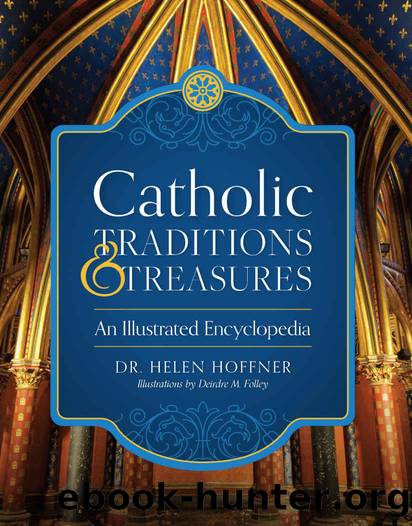Catholic Traditions and Treasures: An Illustrated Encyclopedia by Helen Hoffner

Author:Helen Hoffner [Hoffner, Helen]
Language: eng
Format: epub
Publisher: Sophia Institute Press
Published: 2018-10-23T05:00:00+00:00
St. Patrick
Although Patrick (385â461) was born in England, the Irish have claimed him as their patron because he preached the gospel throughout Ireland. As a child, he was kidnapped by pirates and brought to Ireland, where he was sold as a slave. He spent long hours in prayer while shepherding his masterâs flock. He later escaped by ship but returned to Ireland after being ordained and spread the Faith there. St. Patrick has a second job as the patron saint of engineers because he encouraged the construction of Irish clay churches and he taught the Irish to build arches of lime mortar rather than dry masonry.13 His feast day is March 17.
St. Jude
As one of the twelve apostles, St. Jude (first century) had special ties to Jesus. According to legend, King Abagar asked Jude to bring him a picture of Jesus so that he might be cured of leprosy. Jude took the message to Jesus, who responded by pressing the image of His face into a cloth, which Jude took to King Abagar. The king was cured, and Jude became known as one who could intercede for healings. Statues and holy cards of St. Jude often depict him holding an image of Jesus. St. Jude is the patron saint of impossible causes. His feast day is October 28.
St. Lucy
Lucy (ca. 283â303) was born in Syracuse, in Sicily. Although she lived during a time when belief in Christ was punishable by death, St. Lucy clung to her Faith. She was denounced to the governor of Sicily by a young man whom she refused to marry. When she would not renounce her Faith, her enemies had her blinded and then had her killed. St. Lucy has become the patron saint for those who are blind or visually impaired. Her name means âlight.â Her feast day is December 13.
St. Kateri Tekakwitha
Canonized by Pope Benedict XVI in 2012, Kateri Tekakwitha (1656â1680), known as the Lily of the Mohawks, was the first Native American to become a saint. She was born in upstate New York to an Algonquin mother and a Mohawk father. At age nineteen, Kateri heard the Christian message that Jesuit missionaries brought to her village and was later baptized. Her family rejected her for following the Catholic Faith and for refusing to marry a Mohawk warrior. Because she had to flee her village, St. Kateri Tekakwitha has become known as the patron saint of those in exile as well as the patron of ecology because she often prayed in the forest. Her feast day is July 14.
St. Thomas More
Lawyers, civil servants, and politicians look to St. Thomas More (1478â1535) as an example of integrity. He was chancellor of England under King Henry VIII but refused to accept the king, rather than the pope, as the head of the Church. Because he would not deny his Faith to remain in the kingâs good graces, St. Thomas More was martyred. He shares a feast day with Bishop John Fisher, who was also martyred under Henry VIII, on June 22.
Download
This site does not store any files on its server. We only index and link to content provided by other sites. Please contact the content providers to delete copyright contents if any and email us, we'll remove relevant links or contents immediately.
Resisting Happiness by Matthew Kelly(2887)
The Social Psychology of Inequality by Unknown(2311)
Designing Your Life by Bill Burnett(2265)
Day by Elie Wiesel(2242)
The Giving Tree by Shel Silverstein(1837)
Angels of God: The Bible, the Church and the Heavenly Hosts by Mike Aquilina(1628)
Human Design by Chetan Parkyn(1574)
Augustine: Conversions to Confessions by Robin Lane Fox(1473)
The Supreme Gift by Paulo Coelho(1446)
Hostage to the Devil by Malachi Martin(1396)
7 Secrets of Divine Mercy by Vinny Flynn(1392)
Jesus of Nazareth by Joseph Ratzinger(1378)
Dark Mysteries of the Vatican by H. Paul Jeffers(1341)
The Vatican Pimpernel by Brian Fleming(1340)
Saints & Angels by Doreen Virtue(1311)
St. Thomas Aquinas by G. K. Chesterton(1306)
My Daily Catholic Bible, NABRE by Thigpen Edited by Dr. Paul(1207)
Called to Life by Jacques Philippe(1201)
The Ratline by Philippe Sands(1165)
